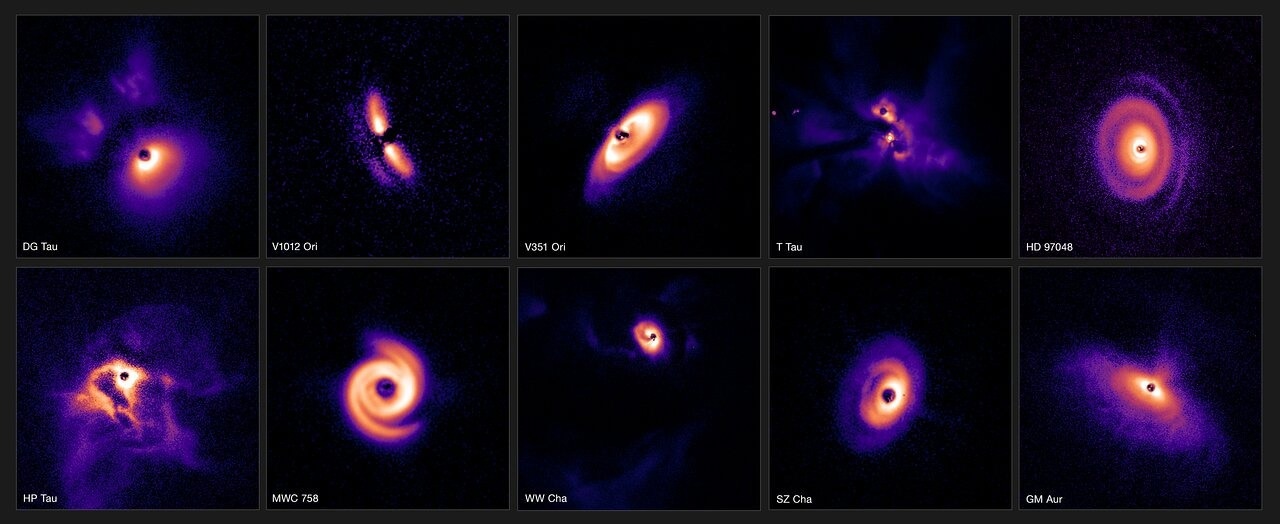Reviewed by Lexie CornerMar 6 2024
A group of astronomers has provided fresh insights into the intricate and interesting process of planet creation through several investigations.
 Planet-forming discs in three clouds of the Milky Way. Image Credit: European Southern Observatory
Planet-forming discs in three clouds of the Milky Way. Image Credit: European Southern Observatory
The stunning images taken in Chile with the Very Large Telescope (VLT) of the European Southern Observatory (ESO) are among the most extensive surveys of planet-forming disks ever conducted. The study combines observations of more than 80 young stars around which planets can form. It provides astronomers with a wealth of information and unique insights into how planets form in different regions of the galaxy.
This is really a shift in our field of study. We’ve gone from the intense study of individual star systems to this huge overview of entire star-forming regions.
Christian Ginski, Study Lead Author and Lecturer, University of Galway
More than 5000 planets have been found around stars other than the Sun, many of which are much more distant from the solar system. To understand where and how this diversity arises, astronomers must observe the dust- and gas-rich disks that envelop young stars—the very cradles of planet formation. The best place to find them is in massive gas clouds where the stars themselves form.
Like mature planetary systems, the new images showcase the extraordinary diversity of planet-forming disks.
Ginski added, “Some of these disks show huge spiral arms, presumably driven by the intricate ballet of orbiting planets.”
Antonio Garufi, Astronomer and Lead Author of Arcetri Astrophysical Observatory, Italian National Institute for Astrophysics (INAF), added, “Others show rings and large cavities carved out by forming planets, while yet others seem smooth and almost dormant among all this bustle of activity.”
The group examined 86 stars in all, located in three distinct star-forming regions of our galaxy: Orion, a gas-rich cloud located about 1600 light-years away from Earth that is thought to be the cradle of several stars larger than the Sun, and Taurus and Chamaeleon I, both situated about 600 light-years from Earth. A sizable multinational team of scientists from more than ten nations collected the observations.
The dataset yielded several important insights for the team. For instance, they discovered that large planet-forming disks were less common among stars in groups of two or more in Orion. This is an important finding, considering that most stars in the galaxy have companions, unlike the Sun. The uneven appearance of these disks in this area raises the possibility that large planets may be embedded in them, which would cause the disks to warp and become misaligned.
Even though planet-forming disks can travel hundreds of times farther than the Sun, they only seem like little pinpricks in the night sky because they are located hundreds of light-years away from Earth. The team used the highly advanced Spectro-Polarimetric High-contrast Exoplanet Research instrument (SPHERE) installed on ESO’s VLT to observe the disks. The cutting-edge extreme adaptive optics system on SPHERE compensates for Earth’s atmosphere’s turbulent effects to produce clear images of the disks.
As a result, the team was able to capture images of discs surrounding stars that are typically too dim for the majority of other equipment now in use, even at masses as low as half that of the Sun. The X-shooter instrument on the VLT provided more data for the survey, enabling astronomers to calculate the stars’ mass and age. Conversely, the team gained greater insight into the quantity of dust surrounding some of the stars, thanks to the Atacama Large Millimeter/submillimeter Array (ALMA), of which ESO is a partner.
The group intends to go further into the core of planet-forming systems as technology develops. For example, the team can study the innermost regions around young stars, where rocky planets like ours might be forming, thanks to the large 39-meter mirror of ESO's upcoming Extremely Large Telescope (ELT).
For the time being, these amazing images offer scientists a wealth of information to help them solve the puzzle of planet formation.
It is almost poetic that the processes that mark the start of the journey towards forming planets and, ultimately, life in our own Solar System should be so beautiful.
Per-Gunnar Valegård, Study Lead and Doctoral Student, University of Amsterdam
Valegård, also a part-time teacher at the International School Hilversum in the Netherlands, hopes the images will inspire the pupils to become scientists in the future.
Journal References:
Ginski, C., et al., (2024) The SPHERE view of the Chamaeleon I star-forming region The full census of planet-forming disks with GTO and DESTINYS programs”. Astronomy Astrophysics. doi:10.1051/0004-6361/202244005
Garufi, A., et al., (2023) The SPHERE view of the Taurus star-forming region. The full census of planet-forming disks with GTO and DESTINYS programs. Astronomy Astrophysics. doi:10.1051/0004-6361/202347586
Valegard, P. G., et al., (2023). Disk Evolution Study Through Imaging of Nearby Young Stars (DESTINYS): The SPHERE view of the Orion star-forming region. Astronomy Astrophysics. doi:10.1051/0004-6361/202347452